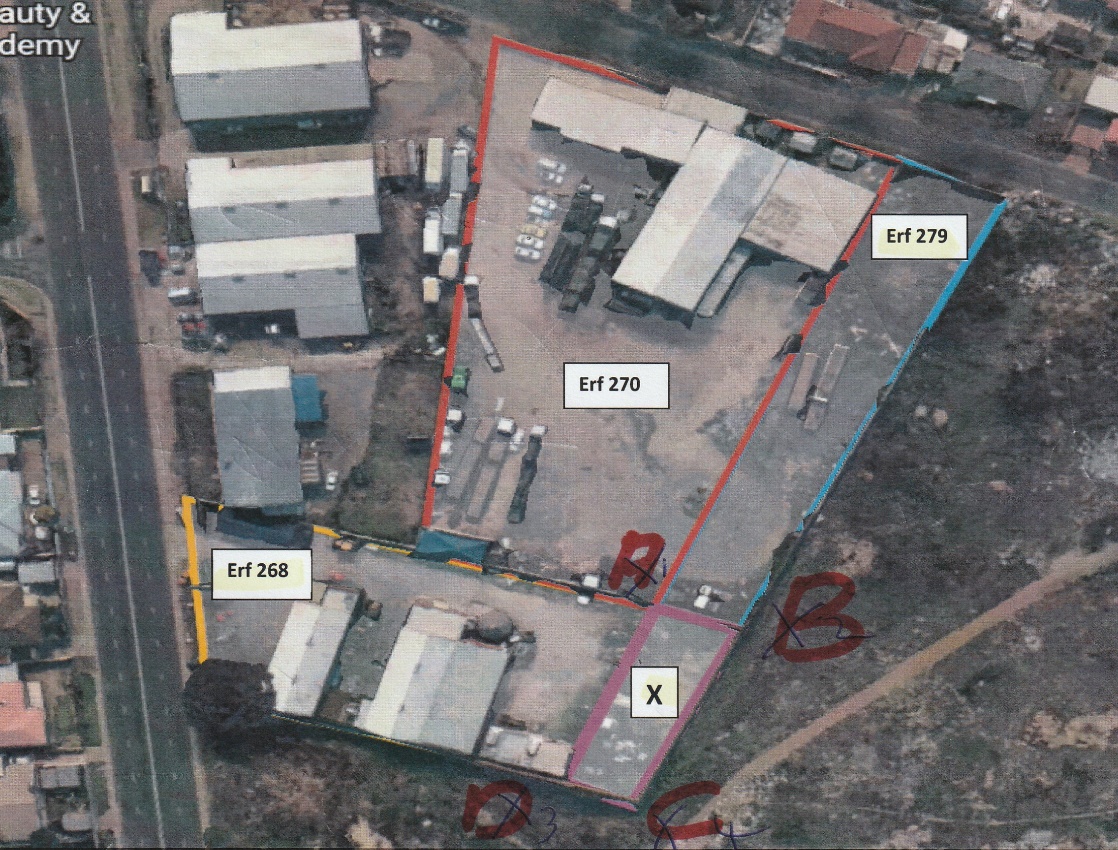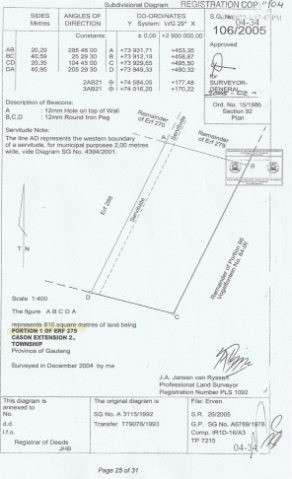
IN THE HIGH COURT OF SOUTH AFRICA,
GAUTENG DIVISION, JOHANNESBURG
CASE NO: 2022-6275
(1) REPORTABLE: NO (2) OF INTEREST TO OTHER JUDGES: NO DATE SIGNATURE
In the application by
ANPHIL INVESTMENTS (PTY) LTD | Applicant |
and | |
OGM MINING SUPPLIES CC | Respondent |
JUDGMENT
MOORCROFT AJ:
Order
[1] In this matter I made the following order on 20 June 2023:
1. Directing the respondent to restore to the applicant possession of Portion 1 of Erf 279, Cason Extension 2 Township, Province of Gauteng, identified by letters A-B-C-D-A on the diagram attached as “X” herewith, within thirty days of the date of this order;
2. In the event that the respondent fails to comply with the order, the Sheriff is authorised to take control of the said Portion, evict the respondent, and to restore possession to the applicant;
3. The applicant is authorized when in possession of the Portion to demolish the wall identified by A-B on the diagram that separates Portion 1 and the Remainder of Erf 279;
4. The respondent’s counter-application is dismissed;
5. The respondent is ordered to pay the applicant’s costs of the application and counter-application.
[2] The reasons for the order follow below.
Introduction
[3] The applicant is the owner of Erf 279, Cason Ext 2 Township, Province of Gauteng. This application is concerned with Portion 1 identified by the letters A-B-C-D-A on the diagram attached herewith as annexure “X”. Portion 1 forms part of Erf 279.
[4] Portion 1 is also identified in the papers as “Portion X” as shown on a photograph that forms part of the papers:

In limine: The authority of the deponent of the founding affidavit
[5] The respondent alleged that the deponent to the applicant’s founding affidavit was not properly authorised.
[6] The respondent never invoked the provisions of Rule 7 of the Uniform Rules.1 There is no merit in the contention that the applicant’s deponent did not have authority. The deponent is identified as the Managing Director of the applicant and I am satisfied that as the Managing Director the applicant is indeed properly represented before the Court.
The merits
[7] The respondent purchased Erf 268 from the applicant in the year 2002. Erven 268 and 279 share a common boundary indicated by the letter A-D on the diagram referred to above.
[8] At the time of the sale both parties were under the impression that Portion 1 formed part of Erf 268. Erf 268 was transferred to the respondent and the description in the deed of transfer correctly reflects the extent of the property as 2 791m².
[9] The deed of transfer forms paper of the papers but the deed of sale did not find its way into the papers. Neither party has a copy. This is unfortunate, and it is therefore not possible to refer to the description of the property in the deed of sale. The size of the property is accurately reflected in the deed of transfer and one is left to speculate about the description in the deed of sale. Be that as it may, the real rights that were transferred are accurately reflected in the deed of transfer. It follows that ownership of Erf 268 passed from the applicant to the respondent.2
The proposed subdivision of Erf 279 and the consolidation of Portion 1 with Erf 268
[10] During 2003 or 2004 the parties became aware of the true boundaries of Erf 268. It was then envisaged that Erf 279 be subdivided and that Portion 1 be consolidated with Erf 268. Town Planners were appointed to advise on the subdivision and consolidation. The deponent to the answering affidavit signed3 a special power of attorney appointing the Town Planners in July 2004 and land surveyor diagrams were prepared that same year.
[11] The respondent knew of the error by July 2004 and there is evidence that the applicant knew already in July 2003.
[12] The applicant’s evidence is that such a consolidation would have required an agreement that complied with section 2 of the Alienation of Land Act, 68 of 1981. The respondent argues however that no such agreement would have been necessary as the consolidation would have been done in fulfilment of the applicant’s obligations in terms of the deed of sale.
[13] The failure to put up the deed of sale is fatal to this argument. The obligations of the parties as contained in the deed of sale are not known. It is also common cause that the deed of sale provided for the sale of Erf 268 as it then existed, and not Erf 268 as consolidated with a portion of Erf 279. This follows from the fact that neither party knew of the true boundaries of Erf 268 when the deed of sale was signed.
[14] Surprisingly, the respondent’s deponent expresses his surprise at the fact that the consolidation process was never finalised. He states in paragraph 4.7 of the answering affidavit: “It would now appear as if the applicant failed to register the approved consolidation”. It is incomprehensible that consolidation could have occurred without the knowledge of the respondent as owner of the property. It is then stated that the “effect of the approved consolidation would have been to transfer the whole property as initially pointed out to the” respondent by the applicant.
[15] It is also common cause that no subsequent agreement was entered into that provided for subdivision and consolidation, or that provided for the transfer of Portion 1 to the respondent. The applicant testifies that the requirements of the local authority could not be met and for this reason the envisaged subdivision and consolidation was not implemented.
[16] On 2 March 2022 the parties entered into a second4 written agreement. The parties noted that the applicant had sold Erf 270 (a property adjacent to both Erf 268 and Erf 279) and Erf 279, and that it was a condition of that sale and of the mortgage bond obtained by the purchaser that the borderline fence between Erf 270 and Erf 268 as well as the borderline fence between Erf 268 and Erf 279 be restored to “its original position”. It was then recorded that the respondent had agreed to “cooperate and attend to the necessary”.
[17] The parties then agreed that the respondent “undertakes to cooperate and allow (sic) restore the Seller [the applicant] (sic) to the borderline fence between Erf 2705 and 268 as well as the borderline fence between Erf 268 and Erf 279 to its original position”.
[18] The agreement was drawn haphazardly and is by no means a model of clarity. What is clear however is that the respondent agreed to cooperate and to restore the borderline fence between Erf 268 and 279 to the original position as it was before Portion 1 was separated from the remainder by means of a wall erected by or for the respondent. No other interpretation of this second agreement is possible.
[19] The respondent’s deponent now however denies that the agreement was unequivocal. The deponent says that: “Co-operate meant that Respondent would also be compensated for its losses and that it would also benefit in some manner from the restoration of the border.” He then made proposals to the applicant in full and final settlement of the matter and he did so two days later, on 4 March 2022. This was rejected by the applicant and the respondent now regarded the agreement as terminated.
[20] There is nothing in the agreement of March 2022 that gives rise to the interpretation that a second agreement on compensation was going to be entered into.
[21] It would seem that both parties regarded the March 2022 agreement as terminated as the applicant did not rely on it in the founding affidavit. For this reason the order made above is not based on this agreement but on the applicant’s ownership.
The other defences
[22] The respondent relies on a number of defences also relevant to the counter-application, namely –
22.1 An intentional or mistaken misrepresentation of the boundaries of Erf 268;
22.2 The applicant created the impression that it would consolidate Portion 1 with Erf 268;
22.3 The applicant is estopped from claiming Portion 1 because of the instructions given to the land surveyors;
22.4 The respondent is entitled to the diminution in value of the Erf 268 without Portion 1;
22.5 The respondent is entitled to be compensated for the wall it built between points A and B on the diagram referred to.
22.6 The applicant would be enriched if the application were to succeed.
[23] There is no evidence of an intentional or negligent misrepresentation that induced the contract. The respondent’s argument that an intentional misrepresentation must be inferred from the fact that the applicant is unable to explain why it erred in respect of the boundaries can not be accepted.
[24] The misrepresentation of the boundaries was, on the available evidence, not a intentional (i.e. fraudulent) misrepresentation. An innocent misrepresentation which induced a contract does not give rise to a claim for damages but may be relied upon to avoid the contract.6 A negligent or intentional misrepresentation may give rise to a claim for damages and may of course also be relied upon to avoid a contract.
[25] The reliance on enrichment as defence is misplaced. It seems to be related to the counterclaim for what appears to be a price reduction.
[26] There is similarly no merit in the averment that the applicant “created an impression” that she would consolidate Portion 1 with Erf 268 and is therefore estopped from claiming its property. No such “impression” appears from the papers and nor is there any allegation that the respondent then acted to its detriment when the “impression” was created.
The counter-application
[27] The respondent counter-applies for an order that the applicant be ordered to
27.1 complete the approved consolidation process in respect of the property as depicted in the Surveyor General Diagram No 109/2005,
27.2 alternatively that the applicant be ordered to compensate the respondent a fair and reasonable market-related value for the disputed portion of the property as determined by a sworn Property Valuator appointed by the Court,
27.3 that the applicant be ordered to erect a wall “exactly similar to the current walls surrounding the disputed portion of the property”, and
27.4 that the applicant “be ordered to pay the respondent an amount of R250 000.00 as compensation for the wall build by the respondent around portion X of the property”.
27.5 I deal with each counterclaim in turn.
The counterclaim based on the implementation of the consolidation
[28] The consolidation process was never approved and can not be implemented.
[29] There is no agreement that complies with the provisions of Section 2 of the Alienation of Land Act, 68 of 1981, in terms of which the respondent can lay claim to the transfer of Portion 1.
[30] The respondent did not identify any basis for this counterclaim
The counterclaim based for compensation
[31] This counterclaim seems to be based on damages or the actio quanti minoris.7 The respondent’s counterclaim for compensation is not quantified and no application was made to refer the matter to trial or oral evidence for the quantification of any such claim. This is also rather academic as the claim would have arisen by the latest in 2004 and 2005, and would have prescribed three years later.
The counterclaim for the erection of a new wall
[32] This counterclaim is seems to be related to an improvement of Erf 279 but it is not clear what the legal basis of the claim is and where the new wall is to be built.
The counterclaim for payment of R250 000
[33] This counterclaim relates to the expenditure of the respondent on the wall surrounding Portion 1.The claim is not quantified. The wall was erected in 2010, long after the respondent became aware of the incorrect boundaries and knew that subdivision and consolidation would be required for the respondent to become owner of Portion 1. While it is so that the wall was erected at the expense of the respondent, the respondent also had the use of the wall and of the whole of Portion 1 during the intervening thirteen years.
[34] The legal basis of the claim is probably unjustified enrichment or damages. The words of Van Heerden J in FHP Management (Pty) Ltd v Theron NO and Another8 come to mind:
“The respondents have not adduced sufficient evidence to provide that the purported expenditure has in fact been incurred - indeed, the only 'evidence' of such expenditure is a list of expenses annexed to the respondents' answering affidavit. In the absence of any contractual agreement between the parties in respect of the purported expenses, the respondents have not provided any evidence to show that the alleged 'improvements' to the property were either necessary or useful, or that such alleged improvements have maintained or enhanced the market value of the property (see, in this regard, Scott 'Lien' in Joubert (ed) The Law of South Africa vol 15 1st re-issue (1999) in para 54 and the authorities cited by this writer)”
Prescription of the respondent’s claim
[35] The respondent’s claims arose in 2003 or 2004 (or perhaps 2010 in respect of the wall) when the error was discovered. Section 12(1) to (3) of the Prescription Act, 68 of 1969 provides as follows:
When prescription begins to run
(1) Subject to the provisions of subsections (2), (3), and (4), prescription shall commence to run as soon as the debt is due.
(2) If the debtor wilfully prevents the creditor from coming to know of the existence of the debt, prescription shall not commence to run until the creditor becomes aware of the existence of the debt.
(3) A debt shall not be deemed to be due until the creditor has knowledge of the identity of the debtor and of the facts from which the debt arises: Provided that a creditor shall be deemed to have such knowledge if he could have acquired it by exercising reasonable care.
[36] On the common cause facts the inference that any such claim was prescribed by 2008 (or perhaps 2013 in respect of the wall) is irresistible. The respondent argues that that prescription only started running when the applicant launched the application and that the damages will only be suffered in the future.
[37] There is no merit in this submission. The respondent knew in 2004 that the property transferred to it albeit in extent 2 791m² as reflected in the deed of transfer, was smaller than envisaged by both parties when the boundaries were pointed out. At that point in time the respondent had the facts at its disposal to claim damages or a reduction in purchase price. Facts not at its disposal could have been acquired by exercising reasonable care.9
[38] The respondent’s deponent alleges that he first learned of the incorrect boundaries when a letter dated 23 July 2019 was received from the applicant’s attorney. The date of 23 July 2019 is important as if one assumed for the sake of argument that prescription only began running when the emailed letter was received on that date, then the claim would have prescribed on 22 July 2022 before the counter-application was brought. The applicant’s claim is not based on the contract of sale and the respondent can not (and indeed does not seek to) rely on section 13(2) of the Prescription Act.
Conclusion
[39] For the reasons set out above I make the order in paragraph 1.
______________
J MOORCROFT
ACTING JUDGE OF THE HIGH COURT OF SOUTH AFRICA
GAUTENG DIVISION
JOHANNESBURG
Electronically submitted
Delivered: This judgement was prepared and authored by the Acting Judge whose name is reflected and is handed down electronically by circulation to the Parties / their legal representatives by email and by uploading it to the electronic file of this matter on CaseLines. The date of the judgment is deemed to be 22 JUNE 2023.
COUNSEL FOR THE APPLICANT: | I OSCHMAN |
INSTRUCTED BY: | TUCKERS INC |
COUNSEL FOR RESPONDENT: | P A WILKENS |
INSTRUCTED BY: | STRYDOM ATTORNEYS (BOKSBURG) WRIGHT ROSE INNES ATTORNEYS (JOHANNESBURG) |
DATE OF ARGUMENT: | 25 MAY 2023 |
DATE OF ORDER: | 20 JUNE 2023 |
DATE OF JUDGMENT: | 22 JUNE 2023 |
X

1 See Eskom v Soweto City Council 1992 (2) SA 703 (W).
2 See Legator McKenna Inc and Another v Shea and Others 2010 (1) SA 35 (SCA) para 22.
3 The respondent’s deponent stated that he first became aware of the incorrect boundaries in 2019 but it is obvious from the fact that he participated in the appointment of Town Planners in 2004 that he knew in 2004 that Portion 1 did nor form part of Erf 268. Had it formed part of Erf 268 there would have been no need to subdivide Erf 279 and consolidate Portion 1 with Erf 268.
4 The first written agreement was the deed of sale.
5 The fence between Erf 268 and 270 was dealt with and does not feature in this application.
6 See Cockcroft v Baxter 1955 (4) SA 93 (C).
7 See Le Roux v Autovend (Pty) Ltd 1981 (4) SA 890 (N), [1981] 2 All SA 466 (N) and Labuschagne Broers v Spring Farm (Pty) Ltd 1976 (2) SA 824 (T), [1976] 1 All SA 181 (T).
8 FHP Management (Pty) Ltd v Theron NO and Another 2004 (3) SA 392 (C) 405F.
9 See also Loubser Extinctive Prescription 1996 p 101 to 105. See also Van Staden v Fourie 1989 (3) SA 200 (A) 214H-215H.
